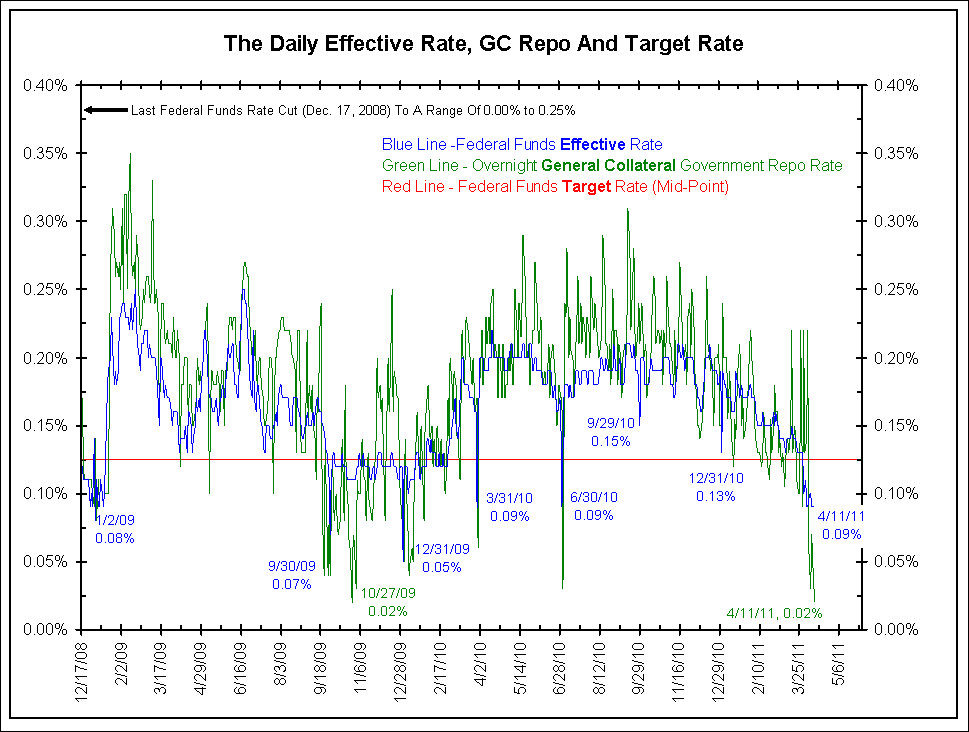Click on chart for larger image

>
• The Financial Times – Repo fee hits money market funds
Hundreds of billions of dollars invested in money market funds face almost zero returns after sharp falls in short-term interest rates. The key interest rate for funding trades in US Treasuries fell to a tiny fraction of 1 per cent on Monday. Nearly a third of the $2,750bn that sits in US money market funds is invested in the repurchase or repo sector, trading in which has been hit by a new charge levied on banks at the start of the month by the Federal Deposit Insurance Corporation. The plunge in short-term interest rates, to just 0.01 per cent, is also due to the temporary absence of some Treasury securities, after wrangling in Washington over the US debt ceiling, that would help soak up excess cash. Bearish positions in government bonds by dealers is another factor behind the squeeze in rates.
• Zero Hedge (Hedge) – GC At 2 bps Means Repo-IOER Carry Is Dead: Long Live FX Carry
As we discussed extensively last week, the Repo-Excess Reserve is now officially dead: the O/N GC rate just printed at a ludicrously low rate of 2 bps confirming that the Fed’s future attempts to normalize the short end will be very entertaining to watch. A bigger problem is that now banks which previously had this “free money” trade to rely on for guaranteed Fed-funded profits are now straight out of luck.
Comment:
We first discussed this fee last week:
The chart above illustrates the highlighted passage. Other than quarter-end anomalies associated with financial statement dates, the current effective funds rate is now at its lowest level since the Federal Reserve last cut rates in December 2008.
Regarding the new FDIC fee, Barclays’ explains it well:
The IOER [Interest On Excess Reserves] rate is the highest overnight front-end rate in the market. For institutions with the ability to deposit cash at the Federal Reserve, the IOER level has been a boon. These institutions can borrow cash, in say, repo or fed funds, and deposit the proceeds at the Fed to earn the spread.The FDIC increased the assessment base (effective last Friday) on which it charges US banks for deposit insurance – raising the base from just deposits to the difference between total assets and tier 1 capital. At the same time, the FDIC lowered the average assessment rate that banks pay so that – at least for most banks – the total insurance charge is unchanged. However, since the assessment now applies to total assets, the return to the IOER arbitrage trade is lower. Instead of earning IOER-GC, the bank now earns IOER-GC-ai, where ai is the bank’s assessment rate. Figures from the FDIC indicate that for most (large and complex) institutions ai is between 2.5bp and 45bp. If the assessment rate for an individual institution, ai is equal to or greater than (IOER-GC), the bank has no financial incentive to do the arb trade – that is, it earns a negative return for simply transferring cash to the Fed.
Why do we bring this up? It calls into question the Federal Reserve’s ability to raise rates. With a massively over-reserved banking system, the Federal Reserve cannot apply a “degree of pressure” on reserves to raise rates as it did prior to 2008. Now it has to use the new tool of IOER [Interest On Excess Reserves]. However, if the FDIC fees render this rate ineffective unless rates are raised in 50bps to 75bps chunks, the Federal Reserve may not elect to move rates as these types of moves would be misunderstood.
This means the Federal Reserve must first drain excess reserves using tools such as reverse repos, term deposits and by selling securities. If so, do not expect a rate hike for a long-time, possibly years.


What's been said:
Discussions found on the web: